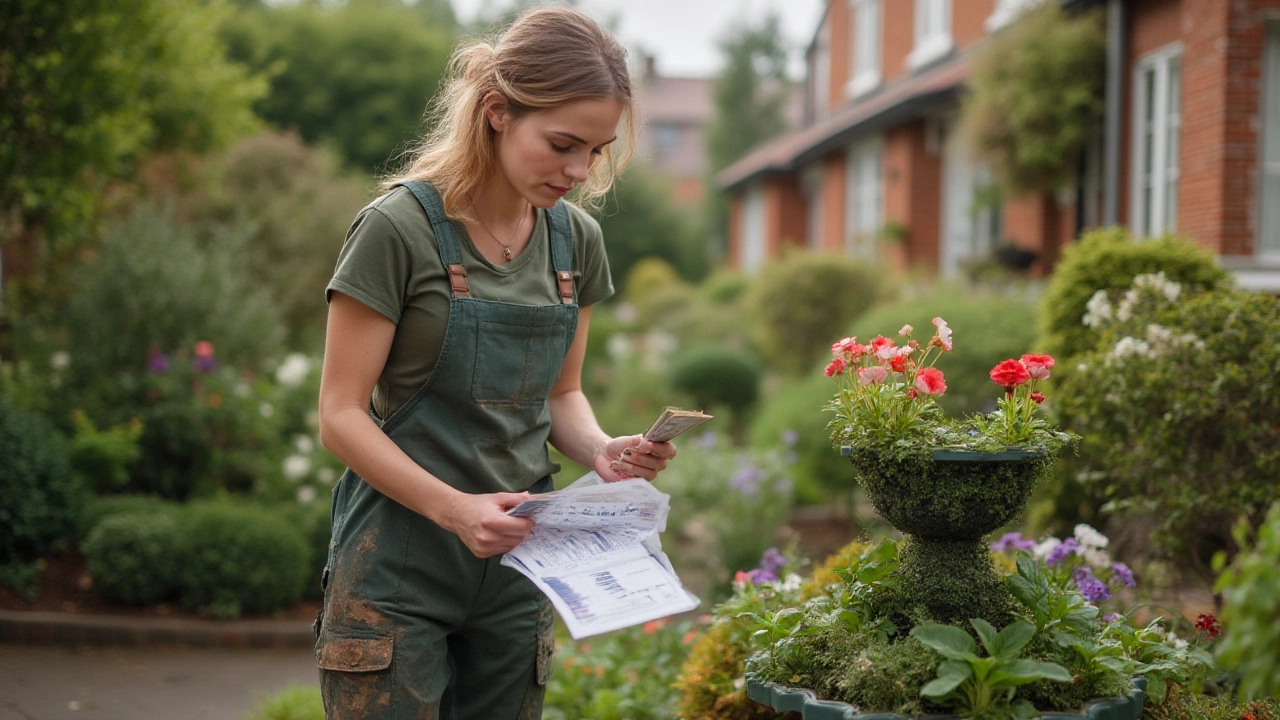Ever heard of a landscaper pulling in six figures? It isn’t always the picture people imagine when they think of mowing lawns or laying mulch. Yet that’s a real possibility. The world of landscaping is much broader and more creative than folks give it credit for—and at the top, the paychecks can hit heights that surprise most people.
If you know someone in landscaping, you might also know they rarely clock out at five. The top earners in this field are hustlers, business owners, designers, and often risk-takers who have figured out how to turn soil and leaves into serious money. So what’s the actual top pay for landscapers? Grab a coffee, because the answer covers far more than throwing sod on a lawn. Let’s dig in.
Breaking Down Landscaper Salaries: The Pay Range and What Influences It
The pay for landscapers can swing from minimum wage up to executive-level incomes. The U.S. Bureau of Labor Statistics pegged the average hourly wage for a standard landscaper at about $18.00 in 2024—roughly $37,000 a year if you’re full-time and working steadily. But that’s just the start. The real money comes once you move up to the top tier, where experience, creativity, location, and even luck come into play.
If you’re just starting out, expect to work long days for modest pay. Entry-level laborers might see annual earnings anywhere between $28,000 and $35,000 depending where they live. Things start getting interesting as you move into specialized work. For instance, irrigation technicians, garden designers, and paver installers typically earn higher wages, sometimes $50,000 to $60,000 a year if they are skilled and reliable. If you become a foreman or crew leader, expect a bump in pay—some hit the $50,000 to $70,000 mark thanks to coordinating larger teams and handling customer projects directly.
What about location? Like in real estate, location shape everything in landscaping pay. Landscapers in wealthy urban enclaves or resort towns pull in bigger checks than those in rural midwestern areas. For example, in places like San Francisco or New York, a seasoned landscape designer might command $45 per hour or more, with annual earnings easily crossing the $90,000 line. In the South or Midwest, even experienced landscapers often earn less, sometimes topping out near $60,000 unless they run their own business.
Owning your own landscaping company is where ‘top pay’ really comes alive. Successful landscape business owners can make $100,000 a year—or far more. Some landscape contractors, especially those with big commercial accounts, report annual profits up to $250,000. There are top-tier luxury designers whose one-time projects net them $50,000, even $100,000 or more, thanks to wealthy clients who want that “wow” factor in their front yards. These people might only book a handful of big jobs per year but make more from one job than most make in a whole season.
Here’s a look at real wages reported by role and experience:
| Job Title | Typical Pay Range (2024, USD) |
|---|---|
| Entry-Level Landscaper | $28,000–$35,000 |
| Experienced Landscaper / Crew Lead | $45,000–$70,000 |
| Landscape Designer | $50,000–$90,000+ |
| Landscape Architect | $70,000–$120,000+ |
| Landscape Business Owner | $60,000–$250,000+ |
What pushes a salary toward the top? Certifications and licensing make a massive difference. A board-certified landscape architect can double the pay of a regular installer or gardener. Designers who master software like AutoCAD or SketchUp stack up more business, and those with a knack for working with rare plants or creating eco-friendly landscapes fetch premium rates. The demand for sustainable, ‘green’ landscapes keeps rising, meaning more clients are seeking creative, technically skilled landscapers—boosting top salaries across the industry.

How the Best Landscapers Boost Their Earning Power
There’s nothing simple about building a six-figure landscaping income. Nearly all high earners do one, if not all, of these things: expand their skills, specialize in high-demand jobs, run teams or companies, and never stop hustling for new clients. If you’ve seen those breathtaking backyard oases on Instagram, odds are there’s a designer behind that who isn’t mowing lawns for pocket change.
One of the quickest ways to move up the pay ladder is picking a niche. Specialty areas like hardscaping—think patios, water features, and outdoor kitchens—pay much more than general labor. Hardscape installers with a track record for quality work can rack up $80,000 or more when business is humming. The same goes for landscape lighting experts and irrigation professionals. These roles often require technical training, and in some states, you must carry licenses, but the payout matches the skill.
If you’re more the entrepreneurial type, starting your own landscaping company unlocks the highest earning potential. This is risky—failure rates for new landscaping businesses can be high—but those who nail marketing, build a solid client base, and grow a good team can make hundreds of thousands per year. Getting commercial contracts—a local retail center, school system, or city parks department—can transform a small business overnight. Retainer agreements keep money flowing year-round instead of hustling job-to-job.
Designers and landscape architects work differently, putting creativity and planning at the center. These pros get paid for their ideas, not just their labor. Many charge by the project, not by the hour, earning $4,000–$20,000 per design for larger residential spaces. When you add consulting fees and project management to the mix, these numbers go even higher, especially when working for high-end clients who want magazine-worthy outdoor spaces. The highest paid landscape architects in the U.S.—the top 10%—clear $120,000 or more per year. Some even jump into public speaking, teaching courses, or publishing books, bringing in income on multiple fronts.
If you want to stand out, education and visibility matter. Getting certified by the National Association of Landscape Professionals (NALP) or the Association of Professional Landscape Designers (APLD) is a fantastic credibility booster. Sharing your work—showcasing before-and-after shots on social media, speaking at garden shows, or even just getting reviews on Google—sets you apart. I know a guy in Austin who landed a $50,000 backyard project just because his Instagram feed caught the eye of a celebrity chef opening a new restaurant. That’s the power of self-promotion.
Want more tips? Here’s what helps landscapers climb the ranks and earn top pay:
- Learn business basics—know your costs, price competitively, and keep books tidy.
- Network with local realtors and home builders—they’re goldmines for referrals.
- Keep up with trends—like edible gardens, native planting, and smart irrigation.
- Invest in good tools and technology—drones for site surveys, CRM software for managing customers, design apps for visuals.
- Offer bundled services—combining lawn care, maintenance, and seasonal plantings keeps clients coming back.
- Deliver killer customer service. Word of mouth is everything in this business.
Those who go the extra mile—taking extra calls at night, fixing issues without being asked, leaving every jobsite cleaner than they found it—they’re the ones whose reputation (and bank accounts) grow. It can be exhausting (just ask Cassandra; she gets tired of me talking plants at dinner), but the results can be worth every blister and sunburn.

Is High Pay in Landscaping Sustainable? Trends and Real-World Insights
Money in landscaping is always linked to hard work, smart strategy, and a dash of luck. Market forces shape the top end of pay, and right now, those forces look promising for anyone willing to put in the work. The value of property keeps rising—people want their yards to match their homes. In real estate, curb appeal adds up to 10% to a home’s value, sometimes more, motivating homeowners to invest heavily in landscaping. Commercial spaces, too, are turning green; businesses want to attract customers with beautiful, welcoming exteriors.
The big winners are those who jump into trends early. Sustainable landscapes, xeriscaping (low water use gardens), pollinator-friendly plantings, and outdoor living spaces are hotter than ever. Commercial landscapers embracing eco-friendly installations and smart irrigation systems often land contracts worth hundreds of thousands over the life of a project. Some companies are even signing 5–10 year maintenance agreements, guaranteeing stable, high income for the foreseeable future.
Automation and robotics are creeping in too—robotic mowers, automatic irrigation, and even AI-driven design software speed up work and let professionals take on more clients with less physical grind. Those who leverage these tools get more done and set their own higher rates. The landscapers stuck doing everything by hand are falling behind, both in pay and productivity.
One interesting stat from 2024: according to IBISWorld, the landscape services market pushed past $130 billion. That’s a massive pie, and the slices for those who innovate or provide luxury services are getting bigger. Some luxury landscaping businesses report average project sizes of $80,000 or more, with projects regularly topping $150,000 for ultra-premium clients. The bar for entry at that level is high—you need flawless service, deep plant knowledge, long client relationships, and often a design or architecture background—but the potential rewards dwarf what most imagine.
Of course, there are risks. Fierce competition, unpredictable weather, and shifts in housing markets can wipe out profits in a bad year. Employee turnover and rising costs for materials have been real headaches since the pandemic. That said, those who adapt, automate, and diversify—say, by offering snow removal or holiday installations in winter—keep the money flowing when the grass stops growing.
So, what’s the actual top pay for a landscaper? For the rare few at the peak—the ones running the biggest shops, landing the largest commercial deals, or designing magazine-worthy estates—it’s not crazy to see annual earnings nudging $300,000 or more. For ambitious mid-career pros, breaking into the $70,000 to $120,000 range is entirely within reach, especially in high-demand urban markets or luxury niches.
If you’re thinking about getting into landscaping or aiming to move up, the potential is there—provided you bring hustle, creativity, and a willingness to learn and adapt. The grass really can be greener on the other side—if you know where to look, and how to make it grow.




